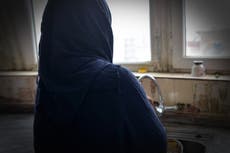India’s population boom tells a story of wealth inequality
The difference in birth rates across the country is stirring debate about how to apportion government spending, write Gerry Shih and Karishma Mehrotra

In recent weeks, two pregnant women in India – Vaishnavi Logabiran and Malika Begum – gave birth to a boy and a girl, adding two newcomers to an Indian population of 1.4 billion that UN officials say is now overtaking China’s to become the world’s largest.
The babies were born weeks apart. But in many ways, they were born into two different Indias. While India’s overall population is no longer skyrocketing – and in fact it’s quickly flattening – UN experts have projected that sometime this month it will finally exceed China’s gradually shrinking population (though they can’t say precisely when). This demographic milestone, however, masks dramatically divergent trajectories inside India, with fertility rates varying sharply from state to state.
In Vaishnavi’s southern state of Tamil Nadu, dotted with factories making cars and iPhones, the average woman will have 1.8 children in her lifetime – the same rate as the United States and Sweden. But in Malika’s Bihar, a fertile agricultural expanse bisected by the Ganges River, the average woman will have three, according to India’s most recent National Family Health Survey, which was conducted between 2019 and 2021.
The lives of Vaishnavi and Malika – and the stories of their home states – illustrate the uneven transformation of India’s north and south, a gap that has widened since the 1980s and continues to vex Indian leaders and policymakers. Not only are southern states providing women better access to contraceptives and family planning services, experts say, but they’re also affording women better educations, more jobs and higher relative social status – crucial, intangible factors that have led to smaller family sizes and greater prosperity.

“Demographically, we have two Indias,” says Arvind Subramanian, the Indian government’s chief economic adviser between 2014 and 2018. “The India of the south already resembles East Asia. It’s actually in the early stages of ageing. But the Hindi heartland is still very much booming.”
Vaishnavi’s daughter was born in a Tamil Nadu hospital about 30 miles from the Bay of Bengal. Malika’s son arrived in a village clinic in northern Bihar, near the Himalayan foothills. Vaishnavi’s and Malika’s households earn roughly the median income for their respective states, but the two mothers’ lives have followed dramatically different arcs: Vaishnavi married after earning a graduate degree in commerce; Malika, like 40 per cent of women in Bihar, married as a teenager, and she never attended a day of school.
Today, Vaishnavi, 27, has two children; Malika, 22, has four. “Two is enough,” Vaishnavi says as she rests in an airy postnatal ward where she and several other women are awaiting surgery to be sterilised. “It was a collective decision of our family.”
Today, the economic and demographic divergence between the two Indias is “becoming a more and more fraught issue”, Subramanian says. “But it’s also an opportunity.”
The north-south gap in birth rates and overall development is stirring frequent debates about how to apportion federal spending and how to allocate seats in parliament. It’s also sparked efforts by government leaders and development experts to provide enough jobs to the poor, northern states – and lift up women like Malika, who are left behind even as India’s surging economy looks destined to overtake Germany’s later this decade.
Sitting in the dry, April heat of north India, Malika says she never learned to read because her migrant worker parents moved the family to faraway Punjab. She never wanted her fourth child, Malika says, but became pregnant because she and her husband feared wearing condoms would give him tumours.
“It’s very stressful to have so many children,” Malika says as Roza, her second child, clings to her leg, wailing for attention. “What’s happened has happened. At least it was a son.”
***
Soon after India gained independence in 1947, its leaders took measures to curb birth rates, which were hovering around six children per woman. Demographers warned of a “population bomb”.
In 1952, India introduced a national family planning programme and a Hindi slogan that became ubiquitous: “hum do, hamare do” – roughly, we are two, we’ll only have two children. In the ensuing decades, the issue became a top priority, and prime minister Indira Gandhi went so far as to oversee the forced sterilisation of millions of men, leading to political upheaval and mass panic.

But as a wave of economic liberalisation swept through India in the late 1980s, the Malthusian nightmare never materialised. Manufacturing and the service sector surged in the south, and the states of Kerala and Tamil Nadu in the 1990s crossed below the “replacement rate” needed to keep a population flat: 2.1 children per woman. India, as a whole, dipped below the replacement rate in 2021, and its population is expected to peak around 2060.
“Where governance has been good, where women’s education and literacy are better, where public health services are better, you’ll see naturally lower population growth rates,” says Poonam Muttreja, executive director of the non-profit Population Foundation of India.
In Tamil Nadu, officials and public health experts say their success can be traced back to the early-20th century, when the activist and politician Erode Venkatappa Ramasamy, widely known as Periyar, launched a social and political movement against caste and gender inequality. Periyar’s movement emphasised women’s education and continues to influence state administrations.
“We give 1,000 rupees to every university-going girl in Tamil Nadu if she finished her schooling from a government school,” says S Senthilkumar, a member of parliament from Tamil Nadu. “Why? Because we want her to study and not marry.”
While the north has made strides in recent years, a significant gap remains. According to the 2021 national family survey, 84 per cent of Tamil Nadu women are now literate, compared with 55 per cent in Bihar, the lowest in India. Forty-six per cent of married women in Tamil Nadu were employed in the last 12 months, versus 19.2 per cent of married Bihari women.
Growing up in the village of Veppambattu outside Chennai, Vaishnavi’s parents – an auto-rickshaw driver and a housewife – had four and six siblings each. But they sent Vaishnavi to school alongside her brother, fully paid by the state, and Vaishnavi eventually obtained a master’s degree, which she turned into a part-time job as an accountant for a small chemical company.
As soon as Vaishnavi became pregnant the first time at age 24, the state’s public health system kicked in. A “village health nurse” – one of thousands posted at Primary Health Centres scattered across the countryside – registered Vaishnavi in the state’s health system. The nurse conducted regular check-ups and accompanied Vaishnavi to a regional hospital when she entered labour.
Even before Vaishnavi gave birth, village nurses and family planning counsellors at the hospital began their pitch: don’t have more than two kids, don’t have them less than three years apart. If the mothers don’t want to be sterilised, they are presented with a “menu” of temporary contraceptive options, freely distributed at primary health clinics and in mobile buses, says S Shobha, former director of the Institute of Obstetrics and Gynaecology in Chennai and a government adviser.

In Tamil Nadu, women who consent to intrauterine devices receive about $2 (£1.60) as a reward. Those who agree to a tubectomy get about $8. Because families still hold a traditional preference for sons, the government offers a hefty cash reward to women who agree to be sterilised after having two daughters. The reward is worth about $240 and put in a trust for the daughters.
The preference for sons has led to a gender imbalance in India. The ratio of baby boys to girls began to surge in the 1970s with the introduction of prenatal testing and legalised abortions. But national data shows the imbalance has finally been shrinking within the past decade as the Modi government carried out a massive campaign to discourage sex-selection abortions. The gender ratio has steadily risen from 918 girls born for every 1,000 boys born in 2006 to 928 girls born for every 1,000 boys born in 2021, according to family surveys.
Programmes encouraging smaller families also exist in Bihar. But data shows the cash-strapped state has lagged behind. The 2021 family survey showed Bihar had one of the highest percentages of women in India who did not want children but could not obtain contraceptives.
Under its long-time leader, Nitish Kumar, Bihar has emphasised improving women’s education as the long-term solution. In 2007, Kumar announced a plan to give eighth-grade girls money to buy bicycles to overcome the cost and dangers of travelling to school – which greatly reduced dropouts in rural areas. Kumar also began distributing free school uniforms and sanitary pads to girls.
“Whatever we have achieved so far is because of that,” Mohammed Sajjid, the programme officer overseeing family planning in Bihar, says regarding women’s education. Still, he adds, more gains “will take more time”.
In a state where conservative attitudes dominate, Bihar’s health workers say attitudes change slowly. At the government hospital in Kishanganj, AK Dubey, a doctor, said women often ask for hormonal contraceptive injections so their families won’t find out they’re using contraception. Other times, Dubey has seen angry husbands show up demanding to know why doctors provided intrauterine devices without their permission.
Still, he’s seen family sizes drift down even from five years ago, when more than six children per family was common, Dubey says. “Women are more aware than their husbands,” he says.
***
Increasingly, India’s failure to close its north-south demographic and economic divide is leading to political consequences.
In Bihar, the pressure on public-sector employment is so great that cuts to government job openings or in military recruitment often spark riots. Meanwhile, southern states such as Tamil Nadu, which is expecting to see its population decline sometime in the next decade, has seen an influx of northern migrant labourers, occasionally leading to friction.
Last month, YouTubers in Bihar were arrested for making a fake video alleging migrant workers were beaten in Tamil Nadu. The videos created a national uproar, and representatives of India’s ruling Bharatiya Janata Party decried northerners being targeted.
For their part, southern states have been increasingly angered by how much tax revenue goes to northern states, which form the core of BJP support.

If north India is to close the gap, the job is likely to fall to frontline workers like Nusrat Jahan, a fiery, overworked 32-year-old who is part of the Indian government’s Accredited Social Health Activist programme.
Jahan prowls through Bihar’s Sontha village, cajoling and haranguing – but mostly haranguing – women to use contraception. Parveen Begum, who has already had 11 children, explains she couldn’t pause from childcare long enough to get the sterilisation surgery. Parveen’s niece, Ruby, who has five kids, says she is afraid of being sterilised.
At the end of a muddy alleyway, Jahan has more success with the family living behind faded, half-constructed walls.
Sitting in the courtyard is Malika, who received an intrauterine device last month after her fourth child. Next to her is her sister-in-law Guljari, who received sterilisation surgery after her second. For years, Malika explains, she didn’t know where to get birth control pills. She and Guljari never used condoms, Malika says, because “the man can die from them”.
Jahan looks exasperated. Finally, Guljari interjects to say that it’s not that women don’t want smaller families. They simply didn’t know how. “We know that having a small family, three kids, two kids, is a happy family,” Guljari says. “Having four or five kids, our life is ruined. We can’t feed them, we can’t educate them, our life is stuck in poverty. We want our kids to become something.”
© The Washington Post
Join our commenting forum
Join thought-provoking conversations, follow other Independent readers and see their replies
Comments





Bookmark popover
Removed from bookmarks